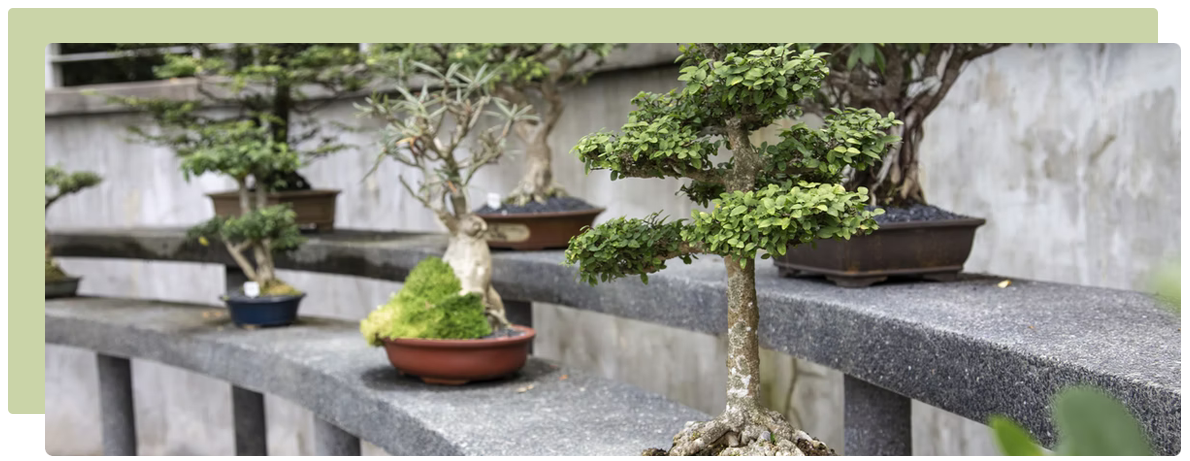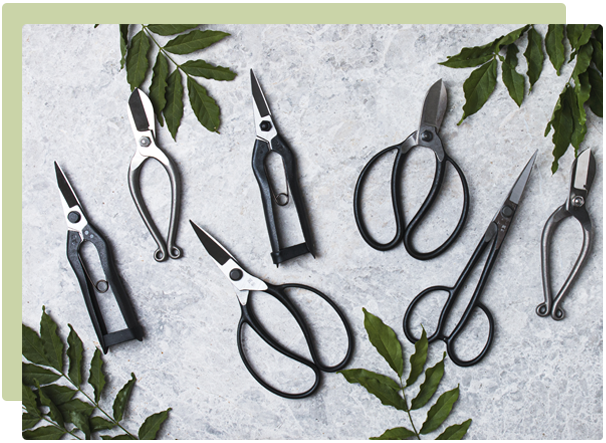Posted by by the Gubba Team
22nd Nov 2021
Bonsai: Care & Cultivation

So you’re thinking of adopting a bonsai? Good choice! These mystical, tiny trees make a special feature in any home or garden. As most people know, a bonsai is a miniature tree, grown in a way that gives it the look of a mature tree. But bonsai are not only small trees, they are artistic representations! In fact, bonsai is an art form that has been practiced in Japan for thousands of years, and learning the techniques of bonsai can be a very rewarding pursuit for any gardener. Read on to learn the basics of bonsai care...
CHOOSING A TREE
Contrary to widely held belief, a “bonsai” is not a specific type of tree. Rather, it is a technique - meaning any tree species can be turned into a bonsai! However, some tree species are more successfully cultivated as bonsai than others. If you are just starting out on your bonsai journey, the first step is choosing a type of tree that is well suited for the conditions in your area.
Where you plan to put your bonsai is a key factor to think about; if you are wanting to place your bonsai outdoors, you will have a much greater variety of trees to choose from. This is because bonsai trees, just like regular trees, enjoy seasonal change. Temperate trees go through a period of dormancy each winter before preparing for a new cycle of growth, so most will not thrive with the consistency and warmth indoors.
However, if your heart is set on having your bonsai indoors there are still a few options. Varieties of ficus can do well in more consistent indoor temperatures, as can some tropical tree species. The bottom line is: do your research on the tree that is best suited for you! Different bonsai will have different care requirements.

WATERING
Your bonsai will need to be watered far more regularly than your average pot plant. This is because bonsai are kept in shallow pots to keep their root systems small. If their soil dries out too much, your bonsai may not survive - for this reason, many bonsai need daily watering.
Be careful though, make sure you don’t over-water your tree! Steer clear of a specific watering schedule - instead, monitor the plant and water as required. As a general rule don’t water your bonsai if the soil is still wet, but definitely ensure that the soil is not left to dry out completely. As a beginner, a good way to tell if your bonsai needs watering is to test the soil with your finger. Stick your finger about 1cm down into the soil, and if the top layer is starting to dry out, it’s time to water.
When watering, you should soak the roots completely. Wait until you see water running out the drainage holes at the bottom before stopping. Again, the amount of water and frequency of watering will depend on the type, age and size of the tree you have, so make sure you check what is recommended for your specific tree species.
PRUNING
Pruning, alongside watering, is the other key step for a successful bonsai. There are two main pruning techniques: maintenance pruning and structural pruning.
Structural pruning is done to give the bonsai it’s basic shape. This involves cutting larger branches. Once you’re happy with the basic shape, you can practise maintenance pruning - this is for maintaining and further refining the shape of your tree. If your bonsai is outdoors, you’ll want to keep the majority of your pruning to spring and summer (i.e. the growth seasons). Indoor bonsai can be trimmed any time of year, but remember to keep any major structural pruning work to once or twice a year at most.
There are many different tools available for pruning bonsai. You can use different scissors and cutters for different parts of the tree. Smaller snips, scissors or tweezers can be used to remove foliage, and you’ll need larger cutters or secateurs for thicker branches.
Regular-sized trees focus most of their growing energy upwards, and to the outer parts of their stems and branches. Bonsai are no different! For the traditional bonsai aesthetic, you’ll want to encourage your bonsai to grow in more central parts (closer to the trunk) by regularly pruning those outer areas of higher growth.
When maintenance pruning, simply cut away any shoots or branches that are growing outside of the shape you’re going for. But remember - be careful not to prune any more than 1/3 of the foliage in one go, otherwise you could cause damage!

FERTILISING
In nature, trees grow their root systems deep into the soil to find nutrients. Bonsai trees (like pot plants) cannot do this - they are dependent on you for any additional supplements! Fertilising is a good way to make sure they are getting all of the essential vitamins and minerals they need.
If you want your bonsai to grow bigger, you’ll want to fertilise regularly. A fully grown bonsai will appreciate some fertiliser as well, but it’s not needed as often. Again, your fertilising routine will depend on whether your bonsai is indoors or outdoors. You can fertilise an indoor plant year-round, while outdoor or evergreen trees will benefit from fertilising from spring right through to late autumn - a lot of your bonsai’s root activity occurs in autumn.
Some recommended bonsai fertilisers include Nitrosol, or Mcgregors Vege & Ornamental fertiliser. An all-purpose fertiliser with balanced NPK levels will also do the trick.

WIRING
Bonsai beginners often stick to pruning to shape their tree, but if you’ve mastered that you may want to learn wiring. This technique allows you to reposition and direct branches by wrapping them in wire. This means you have greater control over the direction and shape of your tree’s growth! Although it sounds somewhat simple, wiring is actually a difficult technique to master.
There are many tips and tricks to learn about wiring bonsai (enough to merit its own blog post!), but to simplify: wiring consists of coiling wire around and along a branch. Coils should be wrapped at a 45 degree angle, and you’ll need to make sure the coils are making contact with the branch all the way around. It will take practise to get the coil tightness just right; too loose and your wiring won’t have any effect, too tight and it could cause damage to the tree! We’d definitely recommend practising on a shrub or bush first, before giving it a go on your precious bonsai.
The thickness of the wire you use will depend on the size of the branch or trunk. Thinner branches will need a more delicate strand of wire, while thicker branches or trunks will require thicker wire. As a general rule, pick a wire that is roughly 1/3 of the thickness of the branch.
Once your bonsai is wrapped, the next step is to gently bend the branch or trunk into the desired shape. Try to do this in one single movement, and avoid manipulating it too much so you don’t damage the bark. Once wired, it will take several months before the branch becomes set in it’s new position. Make sure you keep a close eye on your tree during this time (particularly during growth seasons), as you don’t want the branch to grow around the wire and dig in - if this happens the bonsai could be left with permanent marks.
Finally, when you go to remove your wire don’t unwind it - it’s better to use wire cutters to cut the wire off after each turn. This will ensure you don’t damage your tree. There are many more techniques within the technique of bonsai wiring, so make sure you do some research and practising before you embark on this skill!

REPOTTING
The last aspect of bonsai we’ll cover is repotting. A growing bonsai tree needs repotting about every two years. If you’ve got a mature bonsai on your hands, they can go several years longer without needing to be repotted. This is a good practise to remember, as it not only allows you to add fresh soil and nutrients, but it gives you the chance to trim back the root system if needed.
If your bonsai has roots circling around inside the pot, it’s due for a trim. Trim it back enough that the root system can fit inside the pot without having to fold or force any roots - but remember, never trim more than ⅓ of the root system!
You can then go ahead and add fresh soil back into the pot. A good bonsai soil needs to be well-draining and provide plenty of aeration - definitely do not use regular garden soil on it’s own! A good bonsai potting mix will generally include various mixtures of pumice and other similar well-draining substances. You can create your own bonsai potting mix by mixing pumice with soil.
...YOU’RE READY!
If you’ve made it this far, you’ll have seen that there is a lot to learn about the art of bonsai - and we’ve just scratched the surface! But don’t be intimidated, as bonsai is something that can be learnt and enjoyed by any gardener. It may take patience and care, but practising the techniques of bonsai is very rewarding and can be a life-long pursuit!
You can purchase a bonsai tree from our friends at Simply Bonsai here, an NZ business who specialise in starter bonsai trees. Most of their bonsai are between 3-8 years old. They ship NZ wide!
Visit our dedicated bonsai section here to shop some handy bonsai tools, or seeds for starting a bonsai from scratch.


























